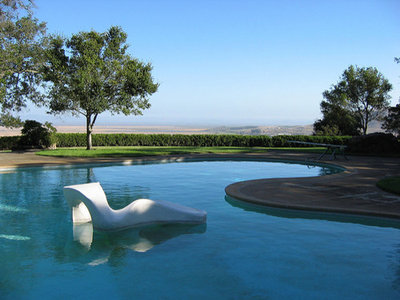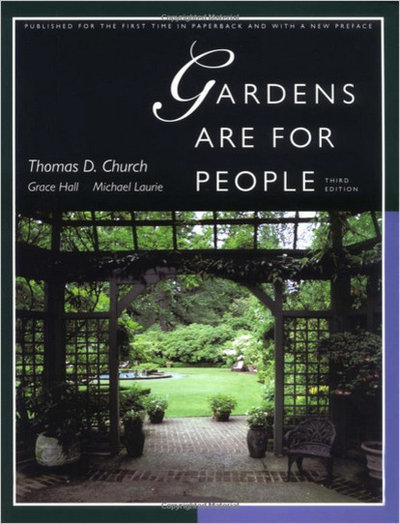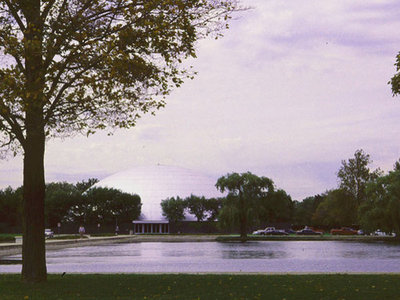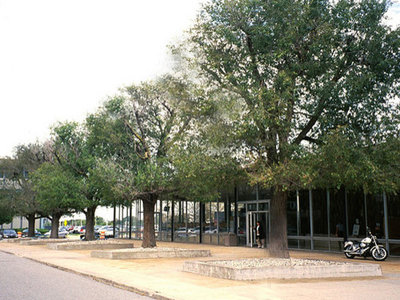Iconic modern landscape architect Garrett Eckbo described Thomas Dolliver Church as "the last great traditional designer and the first great modern designer." Church was instrumental in pushing landscape architecture into the modern movement. His first gig was a terraced garden for his mother, a project he completed at age 12.
Educated at University of California, Berkeley, where he earned a B.A. in landscape architecture in 1922, and later at the Harvard Graduate School of Design, Church was trained in the neoclassical Beaux-Arts tradition, which was very popular in Europe and the U.S. at the time. After graduate school, he took a trip to Spain and Italy on a traveling fellowship. He returned to his native California in 1929 and set up shop. His designs at that point were fairly traditional in style; the principles behind them emphasized the functions of outdoor living and working with the natural landscape. In California this meant he was an early xeriscaper, as he utilized drought-tolerant native plants. He often worked around mature existing trees, which he knew provided important shade and shelter from the wind.
In 1937 Church returned to Europe, this time to study modern art and the works of Le Corbusier and Alvar Aalto. He learned new ways of looking at design, such as cubism and collage, which didn't rely on the Beaux-Arts strong central axis. Church fearlessly pushed into the modern movement and was able to incorporate principles from both styles, including an emphasis on orientation and views, the placement of the house, minimal maintenance and using mature trees for function and sculpture. He designed many residential gardens that married form and function, as well as large projects such as the landscape for the General Motors Technical Center. No matter the style or scale, Church put the needs of his clients first, and then let them and the natural landscape guide his designs.
More icons of design

The Cultural Landscape Foundation
Church's best-known work is the Donnell Garden in Sonoma, California (1948), which may be the most famous modern residential landscape in the United States. The garden is also the quintessential example of California living, which was exploding during the economic good times of the post–World War II era and celebrated in magazines like
Sunset.
Before you go thinking this kidney-shape pool is no big deal, know that this is the original kidney-shape pool. Church invented it. Figures and lines from the expansive views out to San Francisco Bay and its marshes and creeks inspired the pool's shape.

Church collaborated with fellow landscape architect Lawrence Halprin and architect George Rockrise on the project, which contrasts biomorphic shapes in the landscape with the straight modern lines of the architecture. The garden space provides an easy transition from indoors to outdoors, as the California lifestyle includes barbecuing, swimming, gathering and playing outdoor games year-round.
The sculpture that appears to float above the pool is by West Coast surrealist Adaline Kent.

The Cultural Landscape Foundation
The plan for the yard resembles a collage of shapes influenced by the structures and the surrounding region and views.
A checkerboard deck picks up on lines from the architecture and provides a transitional zone between shelter and landscape. The design incorporates existing mature live oaks, with the straight lines of the deck interrupted by the natural forms of the tree trunks.

Amazon
Gardens Are for People, by Thomas D. Church - $41.88
Church begins the book
Gardens Are for People by saying, "In any age of reason, it is the owner who finally decides the size of his garden and the purposes for which it shall be used." He never lost sight of this most important principle.

The Cultural Landscape Foundation
In
Gardens Are for People, Church looks at the shift from formal Victorian ways to the booming housing economy and more relaxed post–World War II culture. "The large lot with a stable has changed to a small lot with a garage absorbed into the house," he notes. "The change from long lace dresses and perambulators to infant nakedness gives us the modern child's play yard," and "the change from high-neck ruffles to bloomers to the Bikini gives us the sun-bathing terrace." Church was instrumental in getting us to think of our landscapes as "outdoor rooms," a term that's now a big part of the home design vernacular.

The car was another relatively new influence in home design during Church's time. Church's plans for home sites, parking spaces, garages, carports, sidewalks and entrances all took the car into consideration.
He thought carefully about the entry experience, from the view of the house from the street to the driveway, parking pad and through the door. He writes, "The psychology of arrival is more important than you think. If it is not obvious where to park, if there is no room to park when you get there, if you stumble into the back door looking for the front entrance, or if the entrance is badly lighted, you have subjected your guests to a series of annoyances which will linger long in their subconscious. No matter how warm your hearth or how beautiful your view, the overall effect will be dimmed by these first irritations."

The Cultural Landscape Foundation
One of Church's larger projects was the 320-acre campus of the General Motors Technical Center in Warren, Michigan, completed in 1955. He collaborated with architect Eero Saarinen, connecting the International-style buildings to the landscape with large-scale moves such as this rectilinear reflecting pool.

The Cultural Landscape Foundation
A line of trees adjacent to the buildings follows a grid that helps tie the buildings to the greater campus.
Thomas Dolliver Church's sketches and writing are still studied, referenced and appreciated today and continue to influence landscape design and theory.
You can see more of his projects at The Cultural Landscape Foundation. To learn more about Church, check out
Gardens Are for People and
Thomas Church, Landscape Architect: Designing a Modern California Landscape, by Marc Treib.





